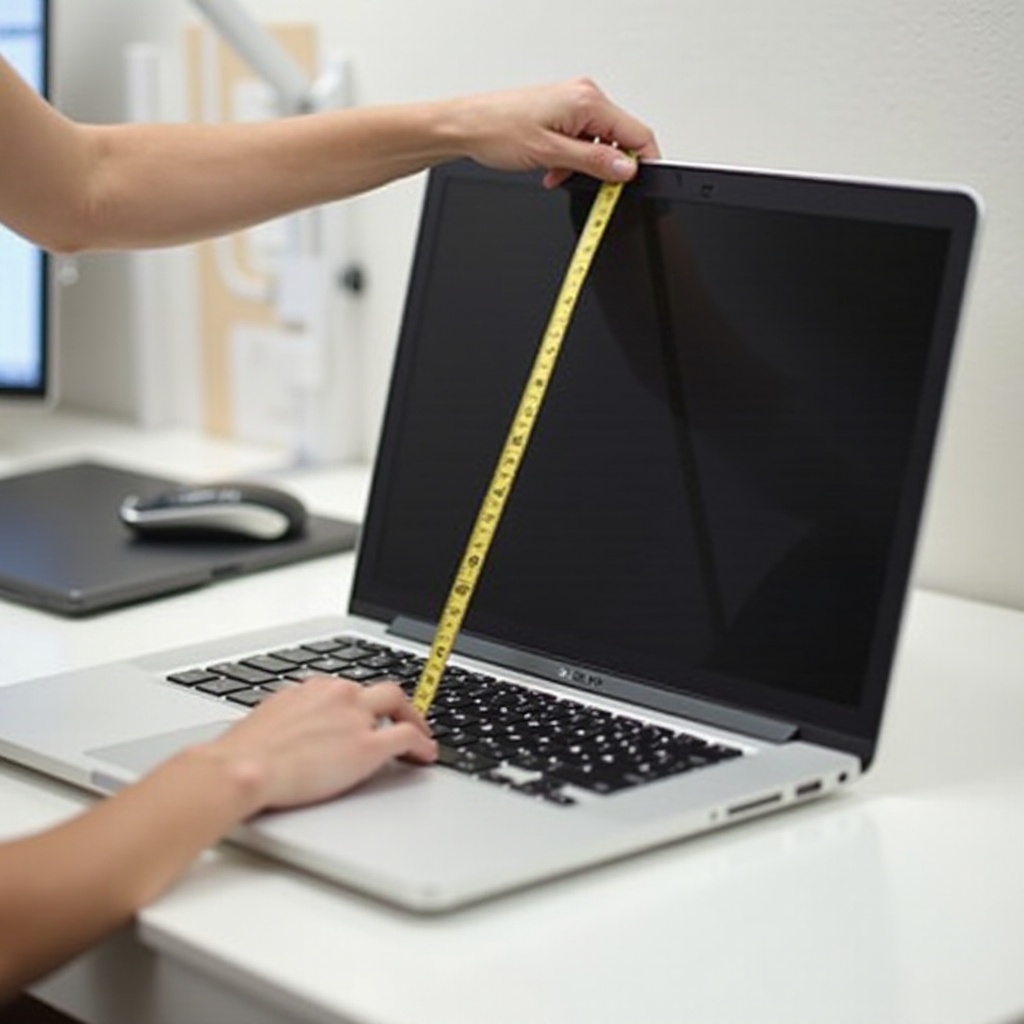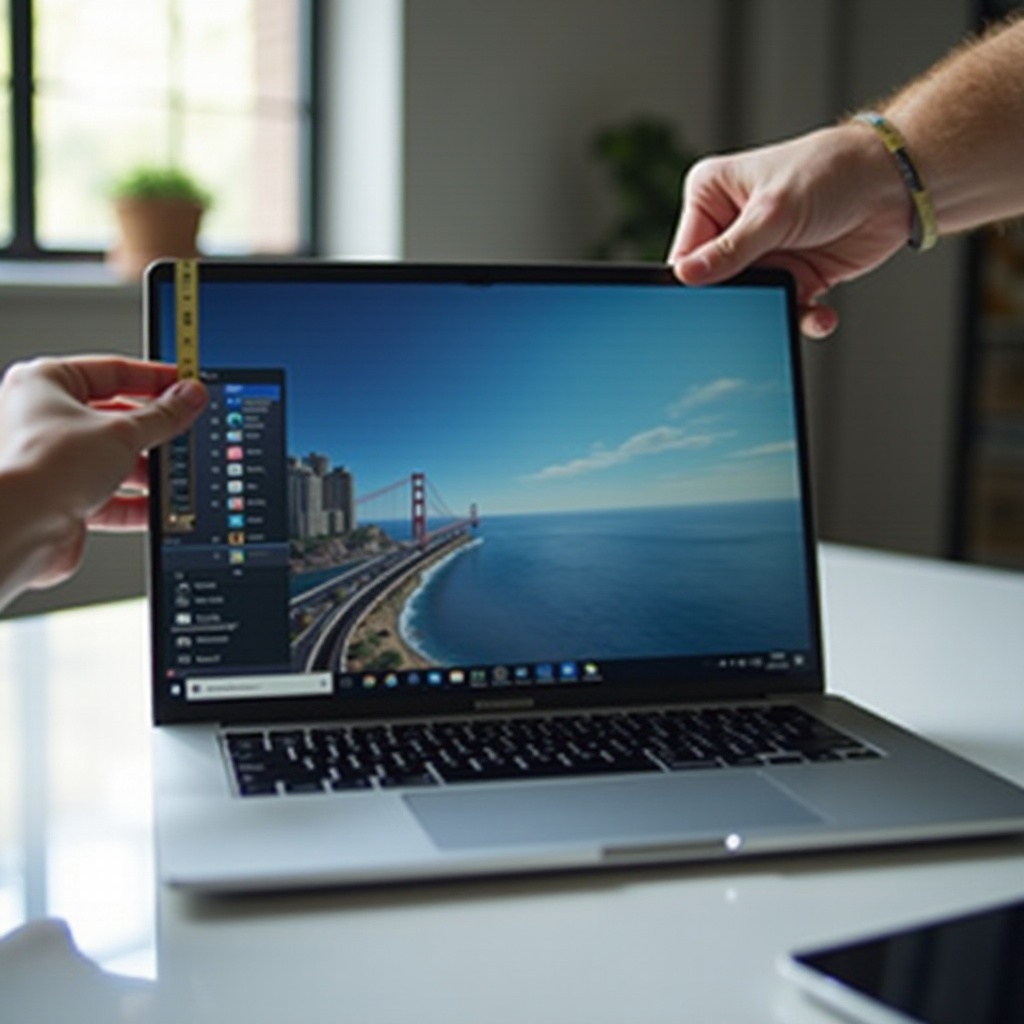Introduction
Knowing your laptop’s screen size can greatly enhance your computing experience. Whether you’re troubleshooting display issues, shopping for accessories, or considering an upgrade, understanding your screen dimensions is essential. This guide will explain various methods to measure your laptop screen, help you grasp the implications of screen size, and offer tips for selecting the ideal size for your needs.

Understanding Laptop Screen Sizes
The size of your laptop screen affects how you interact with your device, influences portability, and impacts usability with the software you use.
Screen Size vs. Resolution
Screen size refers to the physical dimensions of the display, measured diagonally from one corner to the opposite. Resolution refers to the number of pixels on the display. A larger screen doesn’t necessarily mean a higher resolution. Understanding these terms is crucial for making informed purchase decisions.
Common Laptop Screen Sizes
Most laptops offer screen sizes ranging from 11 to 17 inches. Smaller screens, like those on ultraportables, are excellent for mobility but may compromise comfort for extended use. Larger screens are favored by gamers and professionals who require ample screen real estate for multitasking.
With these basics understood, let’s explore how you can measure your laptop’s screen size.
Methods to Measure Your Laptop Screen
Once you understand what constitutes screen size, measuring your laptop screen is straightforward.
Manual Measurement with a Measuring Tape
- Close your laptop: Ensure the screen is clean and free of obstructions.
- Use a measuring tape: Measure diagonally from one corner of the display to the opposite corner, excluding the bezel (the frame around the screen).
- Record the measurement: The number you get is your laptop’s screen size in inches.
Checking Through System Settings
- Windows laptops: Right-click on the desktop and select ‘Display settings.’ The screen size is often listed under ‘Display resolution.
- MacOS laptops: Click the Apple menu icon, select ‘About This Mac,’ then ‘Displays.
Manufacturer Specifications and Online Resources
You can find your laptop’s screen size by looking at the model number, usually found on the underside of the laptop. Visit the manufacturer’s website, enter the model number, and access the specifications.
These methods provide reliable ways to determine your laptop screen size, laying the groundwork for valuing usability and future purchases.

Factors Affecting the Choice of Laptop Screen Size
After identifying your current screen size, consider how it fits your needs and if it aligns with industry standards.
Usability and Portability
If you travel frequently, a smaller, lightweight laptop might be ideal. On the other hand, work that requires multitasking or graphic design may benefit from a larger screen.
Consideration of Use Cases
Understanding your primary use case is crucial. Students might prefer the balance of size and portability, while gamers often favor larger, higher-resolution screens that offer more immersive experiences.
With these factors in mind, informed decisions can greatly impact your choice of a laptop and your satisfaction with your device.
Tools and Resources for Finding Screen Size
In addition to manual and settings-based methods, other tools and resources can streamline the process.
Recommended Online Tools
Websites like ‘Display Wars’ offer comparators that allow you to enter your screen’s dimensions to visualize and compare with others.
Software Applications for Measurement
Applications such as ‘Speccy’ provide detailed hardware overviews, including screen size. This saves time and ensures accuracy.
Using these tools in conjunction with manual checks gives comprehensive insights into finding and understanding your most suitable screen size.
Buying Guide: Choosing the Right Laptop Screen Size
With methods and factors discussed, defining the right screen size becomes clearer with these tips:
Screen Size for Different Types of Users
Identify whether you’re a student, professional, or gamer. Professionals might prioritize efficiency, while gamers could prefer the immersion of a larger screen.
Balancing Screen Size with Other Specs
Consider resolution, battery life, and weight alongside screen size. A 15-inch laptop may vary dramatically in use depending on these other specifications.
By applying this buying guide, you’re encouraged to focus selection processes and prioritize both size and features for optimal satisfaction.

Conclusion
Understanding what size screen your laptop has and what you need empowers you to make the best choice for your lifestyle and work requirements. By combining manual measurement techniques with digital tools and considering personal usage patterns, you’ll adeptly handle current issues and future purchases with confidence.
Frequently Asked Questions
How do I measure the screen size of my laptop without a measuring tape?
Use system settings or manufacturer specs to find this information. Online tools can also assist in estimating the size without manual measurement.
What is the most common laptop screen size in 2024?
The 15-inch screen remains popular in 2024 due to its balance of usability and portability, suiting a wide range of users.
Does the screen size impact the battery life of my laptop?
Yes, larger screens can consume more power compared to smaller displays, influencing battery life and overall energy efficiency.